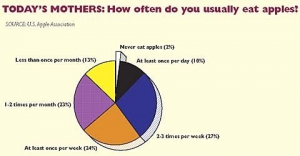Mothers play a critical role as the key decision-maker in purchasing food for themselves and their families. Mothers between the ages of 25 to 38 make up a significant percentage of the U.S. apple industry’s consumer population, and their views affect demand for apples and apple products. The perspective of these mothers provides a valuable foundation upon which growers, packagers, and marketers can reach this key group and develop strategies to enhance the appeal of apples and apple products.
To better understand the perceptions and purchasing patterns for this powerful demographic target, the U.S. Apple Association conducted two focus groups and an on-line survey. Participants included women from various ethnic groups, income levels, employment status, and education levels. Feedback was gathered on topics such as their purchasing and preparation preferences, and their knowledge about apple health benefits, as well as which approaches might encourage them to explore new varieties and consume more apples.
What we know
First and foremost, the groups recognized apples as a “good food.” In most families, both children and adults enjoy apples. The association between apples and good health is one of the reasons many women incorporate apples into their families’ diets. A bonus that encourages women to buy apples for their families is that they fit well into their busy lifestyles. They appreciate the portability and long life that allows apples to be served in lunches and as snacks, offering a healthier option than many other snack foods.
An investigation into women’s apple variety preferences revealed that more women preferred red to green apples (47%) than those who preferred green to red apples (35%). The top three responses to the question “Which of the following varieties of apples have you eaten?” were: Red Delicious (85% of respondents), Granny Smith (80%), and Golden Delicious (73%). Also popular are Gala (61%), McIntosh (60%), and Fuji (58%). Less popular were Rome (34%), Braeburn (26%), Pink Lady (21%), Empire (16%), Honeycrisp (10%), and Crispin (7%).
A survey of the women’s preparation habits revealed that almost three-fourths like to slice apples and then eat them, whereas just over 30 percent prefer to eat apples that are already sliced. Many of them enjoy apple slices served with a sweet dipping sauce. Most women surveyed prefer to eat apples with the peel (68%). There were various “favorite” ways to eat apples, with many respondents choosing more than one way. Respondents reported that the most popular way for children to eat apples was as slices (88%). However, there were a lot of other great choices for children, like eating them whole (68%), in apple pie (54%), and apples with peanut butter (38%). As for other apple products, over 70 percent enjoy apple juice and applesauce, while fewer preferred apple cider (28%). Almost all women surveyed enjoyed their apples as a snack (96%), while 35 percent reported using apples in desserts, and 26 percent eat them with a meal.
What we need
Mothers surveyed also provided valuable insights for the industry, as they discussed suggestions for further enhancing apples’ appeal to consumers. While 98 percent of the women said they were apple eaters, many are falling short of even an apple a day.
On average, respondents eat about four apples a month, with only 10 percent eating apples at least once a day. Just over one-fourth eat them two to three times a week; 24 percent eat them at least once a week; 23 percent eat them once or twice a month, and 13 percent eat them less than once a month. Only 2 percent never eat apples.
Several mentioned not enjoying slicing apples themselves and feel that a greater availability of sliced apples would enhance their convenience. Careful consideration of mothers’ insights and suggestions may assist in developing new strategies to improve the frequency of apple consumption among this group.
Mothers also mentioned that that they would like to be reminded about the benefits of apples, as this will keep apples top of mind. Despite their perceptions of apples as a healthy choice, many mothers are unaware of the specific health benefits of apples but would like to learn more about their beneficial properties. Some mothers would like to have more information on apple products, including apple juice and applesauce, and to know whether they offer the same health benefits as fresh apples.
These women are generally content with their “relationship” with apples because of the apple’s reputation for being nutritious and convenient, but most tend to stick with the varieties that they know their families will eat. Few mothers were willing to risk spending money on varieties that their families may not like. However, these women seemed more willing to explore different varieties if they were more informed about the different types of apples on the shelves and had the option to sample them. They suggested displaying descriptions about the individual types—including taste, nutritional benefits, and recipe suggestions—in the supermarket to improve the likelihood that they would purchase other varieties. Some mothers say that novelties such as the grape-flavored Grapple apples would provide greater incentive for their children to eat apples.
Despite the tendency to stick with the more common varieties, both studies show promising findings for apples. This fruit maintains its popularity among adults and children alike, as mothers recognize that it can serve as a healthy choice that fits conveniently into an active, busy lifestyle for themselves and their families. By continuing to monitor the trends and opinions of its key demographic consumer group, the U.S. apple industry can strive to ensure apples expand their extensive appeal and positive image among consumers.


Leave A Comment